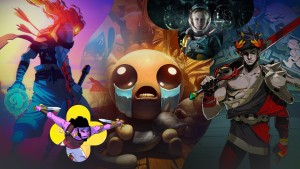Please support Game Informer. Print magazine subscriptions are less than $2 per issue
Ed Boon Moving Beyond Mortal Kombat, Hints On Injustice DLC, And Life After Midway
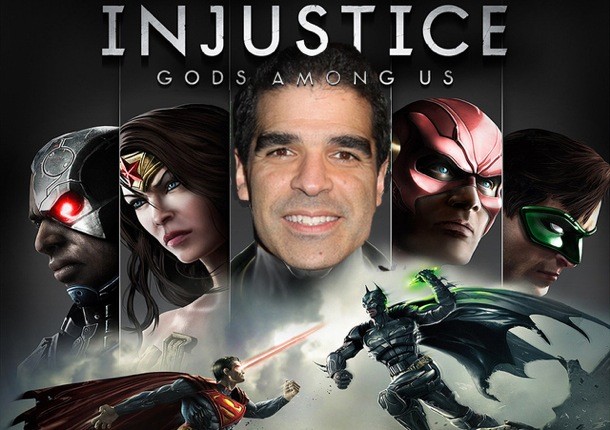
With the launch of Injustice: Gods Among Us this week, we thought it would be a great time to catch up with NetherRealm creative director Ed Boon. During our conversation, we had a chance to talk about how Injustice evolved over its development, the tough choices made when selecting the roster of characters, and some hints about upcoming DLC. We also spoke a bit about life after Midway, and how things have changed for Ed and his team now that they are part of the WB family. Be sure to check out our review of Injustice, and the news of the first announced DLC character.
Game Informer: Injustice is a shift for you and NetherRealm away from Mortal Kombat. I want to talk a bit about the development process that you went through in order to make Injustice its own game and not just Mortal Kombat with DC characters.
Were there challenges in differentiating Injustice from Mortal Kombat, and were there any features or mechanics that you abandoned because they were too iconic to the Mortal Kombat series? Were there any characters that needed to be changed along the way because they were too similar to Mortal Kombat characters?
Ed Boon: It was only tough in that Mortal Kombat is so established and so proven that it's a safe area to hang out. Let's do the block button. Let's do fatalities. Let's do the X-rays. All the stuff that's become synonymous with Mortal Kombat. It would have been more comfortable to have hung out there, but at the same time that wouldn't have let this game carve out its own identity.
So, certain things—fundamental things—like the attack buttons and what they do, adding the power button that's unique to each character, holding away to block, getting rid of round 1/round 2 all of these fundamental, staple things in Mortal Kombat. We wanted to establish a whole new feel for this game.
The biggest challenge was getting past our own comfort level. People on the team said, "Should we really not have fatalities? Should we really not have rounds and the block button?" But once people got used to it and looked at the game from a different standpoint, it felt more natural for this game.
A block button would have meant yet another button for players to remember about. We added this interaction button, and with the goal of keeping the play mechanics simple, we didn't want to add another button. So removing the block button reduced the amount of buttons players had to worry about by one, so it was good.
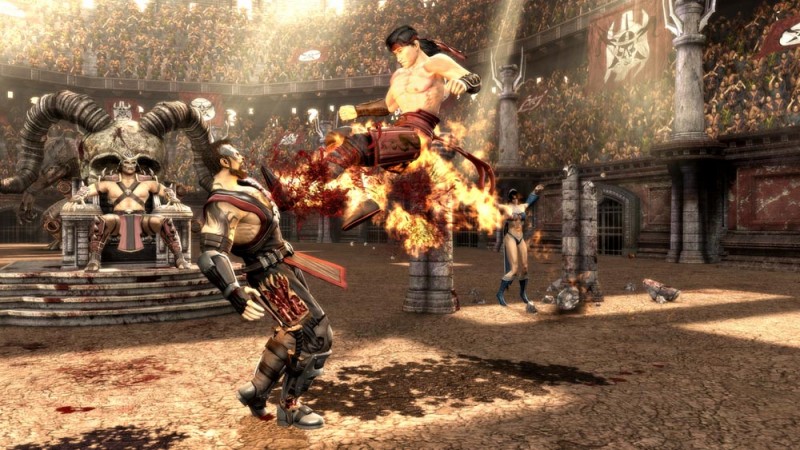
Along those lines, the background interactions, the wagers, etc., were any of those particularly challenging to implement? Did any one more than the others change over the course of development?
The whole clash/wager system had a few permutations as we were developing the game. It used to be something you could do at any point in the game. It used to have a different user interface. After some people asked us, "how does it work," and after enough people ask it's a signal that it could be simpler and easier to understand.
As with many features, we did iterate on that one a few times. The background interactions, they were always going to be a staple of the game. From the very beginning, that was part of the plan, as was having the different class of characters (the power characters, the gadget characters).
The big challenge was coming up with a big enough variety and enough of them in each environment to have them play a good part of the fight without dominating the fight. That was the balancing act that we did there. We're happy with how it ended, because they do play part of the fight, but it's not just that the fight is all about picking up cars and slamming them down on your opponent. It's a combination of the fighting mechanics and taking advantage of where you are.
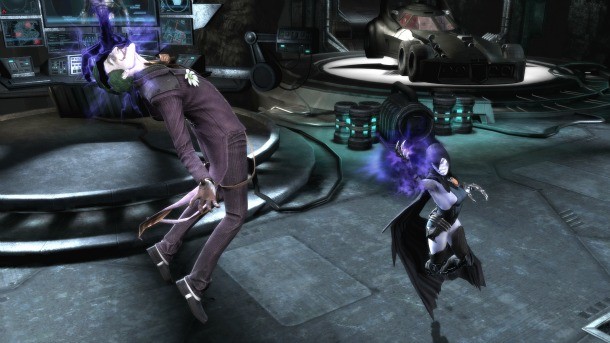
With the way the stages are set up and the background interactions, and the fact that all of them are so different, how did tuning the stages alongside the characters impact the development process?
Dramatically. It opened up such amazingly fun scenarios. You get someone into a combo, you pop 'em up in the air, you get four or five hits in, and lo and behold, you realize that you're standing underneath something that you can jump up and slam it on the guy like an exclamation point on the sentence like a big finisher type thing. All of these opportunities kinda pop up organically.
"Oh my god, if I'm The Flash, I can take advantage of this gigantic tree and slam it on them." I really feel like not all of them have been discovered yet. It just opens up a huge number of different permutations and combinations of special things that can happen. You're adding that other variable that's not only character A versus character B, but also, which background and where you are. For me, that's one of the most exciting things that opened up with that feature.
Read on to find out how NetherRealm chose the roster of characters for Injustice and how life has changed for Ed and his team since their last DC collaboration.

You've done a great job of making Superman a playable character given his invulnerability and strength. Were there any characters that you thought about including that just became too problematic with their power sets, for instance Plastic Man? Were there any characters that you experimented with and said, "this isn't going to work."
To the Plastic Man question, unfortunately, he was never up for consideration for the cast. The reality is that I have one of these big DC bibles that has all the characters in there. Captain Boomerang, Mr. Mxyzptlk, Captain Cold, including Plastic Man and Elongated Man.
When you're talking about 25 characters, with DLC close to 30, at some point you can't… for instance, we never considered the Atom, a character who's three inches tall. They are just so wild, and so out of the picture that they just never made it onto the table. The first maybe fourteen characters kinda wrote themselves.
We weren't going to have a DC game without Superman, Batman, Flash, Green Lantern, Wonder Woman. You have to have Luthor, you have to have Joker. All these guys. That kind of fills up 60 - 75% of the cast. And then you start getting into the more obscure ones like Penguin, Lobo, and other ones like that. It becomes more about which ones we can fit into the story, which ones DC wants.
DC was a great collaborator in this whole thing. That's the longwinded way of saying that Plastic Man was never on the table.
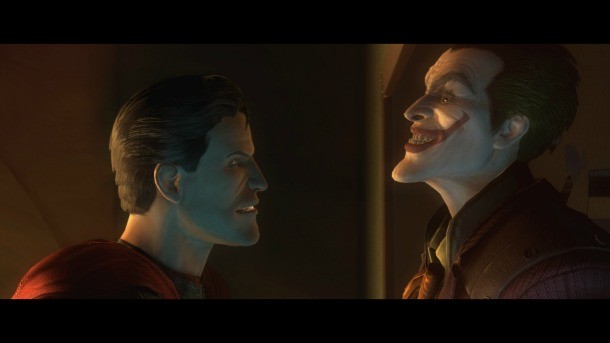
And that was a decision you made, with limited time and resources. Was there anyone that you wanted to use or anything you wanted to do that DC put the brakes on?
People ask me to describe our relationship with DC, and I always describe it as a collaboration. They were not, by any means, an obstacle. They gave us access to all the history of their characters, the various incarnations, and they did say during our initial conversation about the characters and roster—they had not released the New 52 yet, they were going to do it—they knew in their heads which characters they were putting up in the forefront and which ones they weren't going to push as much.
From that standpoint, they told us, "Hey, Cyborg's going to be a big character in our stuff." And we love Cyborg.
We knew at NetherRealm that we wanted to make the baddest Aquaman ever. We're really happy with how he turned out. So everyone has their thing. Honestly, I feel that as the lead of the team, if I had said that I wanted Plastic Man, I could have pushed that through. There were just so many other ones that got ahead of him.
Focusing on the characters, did the nature of the story and the characters' alternate forms influence or change your relationship with them as you were designing their powers?
Not really. I think that we looked at each character, and Green Lantern for instance, we knew was going to use all of these constructs. Same with Sinestro. The Yellow Lantern idea was from the story writers' side, and his moves were a design thing, with the designers driving that. They didn't really take each other into account. It was the spirit of what the characters do. The Flash and his speed, Wonder Woman and the shield and the sword. So, yeah. They were pretty independent.

We talked about creative freedom when it came to DC. Last time you worked with them (not counting the Batman Lockdown iOS game) was in the waning days of Midway. You've had great success with NetherRealm. What's your relationship like with WB, and how is it different than the relationship with Midway, especially at that time you were making Mortal Kombat vs. DC Universe?
The biggest difference between now and when we worked with DC on Mortal Kombat vs DC is that now it's a collaboration. It's a different group of people, but before was like a licensor/licensee relationship sending things out for approval and hearing, "OK. You can do this. You can't do this." It was very much like licensing a product.
You know, we are all now under the same Warner Bros. umbrella, the Warner Bros. family. So, we've been to each other's offices, and it's way more like we're family. Like I said, it's a collaboration. It's more discussion about what would be cool, rather than, "Can we do this?"
From an environment perspective though, obviously WB is doing well, but with what was going on at Midway at the time of Mortal Kombat vs. DC, can you talk about what daily life was like? Looking at these two games, what's daily life like? How has it changed?
Well, it's dramatically better. Kinda like you said, we made Mortal Kombat vs. DC in the eye of the hurricane. There was turmoil spinning all around us. Our team remained intact. If anything, we had this game we were doing and people were excited about it. There was a lot of expectation for it. It was part of the process of Warner Bros. picking us up, in that there was something that was looking very promising.
We just kept our heads down. It was certainly a distraction for me, because we found our home at Warner Bros., I was talking to a whole bunch of other places, representing our studio in some respects.
That took a lot of cycles from me. Now, Warner Bros., the first thing they did when we were acquired was they built us a brand new studio. It's state of the art, and it's just a few blocks from our old one. There's a lot more emphasis on the final quality of the game. The first thing they did with Mortal Kombat was give us six more months to really polish it. The results showed with that game. It's a much more stable environment.
Read on for the conclusion, some hints about upcoming DLC, and NetherRealm's consumer-friendly approach to ensure compatibility with new characters..

Season passes were getting underway when Mortal Kombat came out in 2011. A lot of people look to you as to how to do it right. You laid out what was going to be there, extra costumes came with all of the characters, Freddy was a huge surprise.
Looking at the DLC for Injustice, can you give us the overview for the plans? Will the four characters in the season pass be it, or will there be more beyond that? Is there anything you can tell me about costumes? Are you looking at adding new stages?
There are currently no plans to add new stages for DLC. We are going to have at least four characters. You mentioned Freddy, and he was a conversation amongst us about whether we should do a guest character. Some people thought it was great. Some people were nervous about it. He ended up being the biggest selling one of all.
Beyond the four, there isn't anything we can announce. I certainly don't think I can safely say that it's four and only four. The DLC characters for Mortal Kombat exceeded everybody's expectations. I suppose there is a certain point in time where we can say that there won't be more. I don't think we'll be releasing DLC characters two years from now. At some point, we've got to jump on our next game.
When you say "exceeded expectations," do you mean in terms of fan response or sales?
Both!
In terms of costumes, there's a lot to pull from, the pre-order bonuses, collector's edition, etc. Is the plan to include costumes with each of the DLC characters?
Yes. This game has literally over 100 costumes between pre-order stuff, the ones you can buy, and the ones packed in the game. There's a ton of them. Giving people costumes is the way we can push the other content. For instance, if you download Lobo, we want it so you can play Lobo against me, but I need to have the Lobo content on my machine for you to use him against me. The way we're going to do that is to give away costumes. When you get your free costumes, you'll also get the necessary content to be compatible with everyone, so there's no issue of people not having downloads.
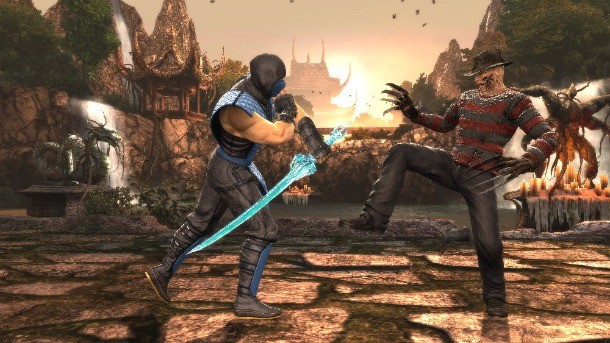
Plus, it has the benefit of being consumer-friendly.
That's really what the goal is. We don't want people to download something and not get something out of it. So we're giving them these free skins.
Switching gears to the iOS game, how much input did you have over that, and how much did your team work on it?
The guys who did the iOS game are the same team that did Arkham City Lockdown. They are located here, in our studio. My involvement is that I play the game and write up comments. I give them my feedback on which areas are strong and which could use some work, and we kinda go back and forth. The main meat of that content is a specific iOS team that we have here. They used some of the assets from the game. We want the games looking similar. We also decided what features were going to unlock back and forth with the two versions.

